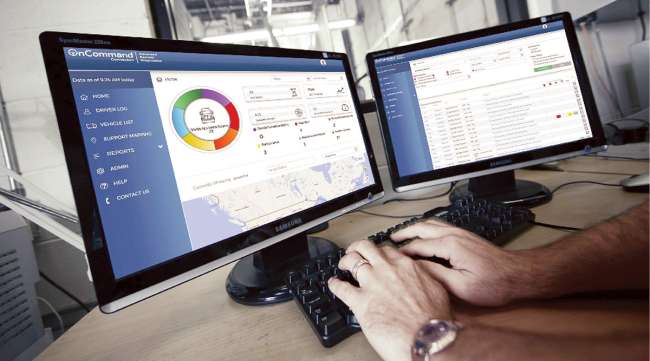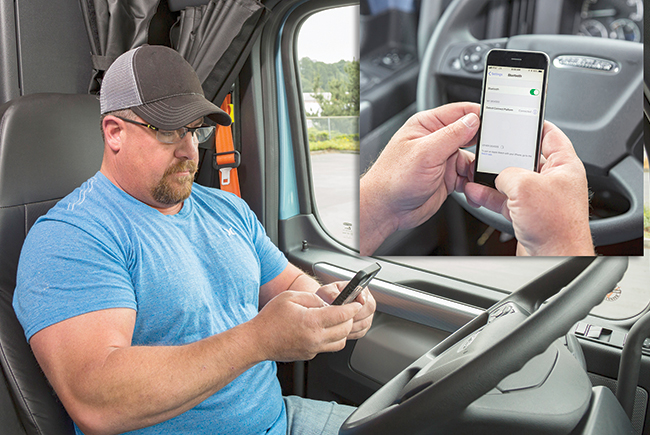Remote Diagnostics to the Rescue

Remote diagnostics systems available on modern trucks are helping fleets avoid costly repairs and reduce vehicle downtime, and this technology is rapidly advancing toward offering better predictions of when problems might occur.
Tom Howard, fleet director for San Francisco-based Veritable Vegetable, said his fleet doesn’t have much flexibility delivering its time-sensitive organic produce. For a while, it seemed every weekend he was answering a call from a driver reporting a check engine light. With limited information, he then would decide whether to drive to a potentially expensive outside shop or return it to company headquarters. It might be a major problem, or it might be a faulty sensor.

Read more feature stories from our second-quarter issue of Equipment & Maintenance Update:
In January 2016, the company began using Kenworth’s “TruckTech+” on 11 of its 28 trucks. For those, he receives an e-mail telling him what the light is signaling and suggesting what to check. On the manufacturer’s website, he can see the truck’s fault code history, helping him determine if it’s a one-time problem or part of a trend. The system also provides the locations of the three closest repair facilities.
“Consequently, I haven’t had to roll a truck into a shop, on the ones with TruckTech+, except for once because I didn’t understand what the problem was,” Howard said. It was a software issue.

Veritable Vegetable uses Kenworth's "TruckTech+" system. (Veritable Vegetable)
At P.A.M. Transport, which operates about 2,000 trucks, the company has reaped the benefits since becoming more proactive with remote diagnostics in recent months, said Paul Pettit, vice president of maintenance.
Previously, the company used fault codes mostly to triage driver road calls. When a check engine light would appear, the driver would be asked to pull the codes himself, which some had trouble doing. Or, drivers wouldn’t contact the company when a light appeared, and the first time the company learned anything was wrong was when the driver called to say the truck had been derated and had slowed to 5 mph.
The company has identified one individual who monitors all incoming telematics from the fleet’s Peterbilt, Freightliner and Navistar models. That information is used to route drivers and ensure dispatchers don’t assign loads to trucks that need service. If necessary, another power unit can be prepared to service the customer.
Not only can the fleet learn what’s wrong, but also how long it’s been happening, the recommended repair, and, in some cases, what nearby shops have the needed parts.
“Pretty much if anything is breaking down right now, we know it when it’s happening or before it happens,” Pettit said.
Tontitown, Ark.-based P.A.M. Transport ranks No. 71 on the Transport Topics Top 100 list of for-hire carriers in North America.
Other fleets also have benefited from remote diagnostics.
Reyes Holdings, a private fleet with more than 4,000 tractors, started using Navistar’s OnCommand Connection in 2016. Annelies Van Thillo, operations analyst, said within a week of rolling out the product, a technician identified two trucks with low diesel exhaust fluid and another with a required regeneration.
At Maryland-based D.M. Bowman, Chief Operating Officer Brian Hall said the 380-tractor truckload carrier saves six to seven hours in downtime per truck per quarter, or about $80 per hour per truck, with the remote diagnostics system his company uses.
Fleets always have operated reactively and still do, according to Kenneth Calhoun, fleet optimization manager for Birmingham, Ala.-based Altec Industries. The difference is that with remote diagnostics, they can shorten that reaction time, he said.
Calhoun, who also is general chairman of American Trucking Associations’ Technology & Maintenance Council, said that while a significant percentage of trucks have the technology installed, fleet adoption varies. Fleets that are progressive elsewhere, such as with electronic logging devices, tend to be the most progressive with remote technology as well. Vocational applications have trailed the rest of the industry, he said.
Providers still are learning what the payment model will look like, Calhoun said. Generally, the service is free for a certain amount of time, and then fleets can subscribe.
Fleets can be overwhelmed by the data, so they must prioritize the information and look for trends, Calhoun said. If a particular group of faults is spiking, the fleet should find the root cause. Fleets should consider a truck’s year model, engine, where it’s domiciled and who is maintaining it. The biggest wins involve finding a problem in groups of vehicles, leading to changes in preventive maintenance, he said.
Looking ahead, Calhoun predicted that in the next 10 years, a vehicle will understand its own issues and then adjust its operating characteristics, allowing the driver to travel to a preferred destination for repairs and updates.
“I think that in our lifetimes, we’ll see the vehicles, for lack of a better way to put it, become self-aware, and then begin to mitigate those situations to extend its life and to optimize the availability of the asset,” he said.
Chris Morrow, fleet management customer service specialist for Entergy, an electric utility, said that because the volume of information can be so overwhelming, fleets should start by focusing on critical codes. Technicians will embrace the technology after seeing it prevent catastrophic failures.
Morrow said Entergy’s main focus has been on its 1,200 medium-duty hydraulic trucks, mostly Freightliners and all with Cummins engines. Following Calhoun’s advice, the fleet focused on those critical codes such as high engine temperatures and low coolant levels.
“That turned out to be fantastic,” he said. “We got those results that we hoped for. Our technicians bought into it, and then twofold, it did end up having a huge financial return for us because those critical codes were just that critical, and they did lead to many of our engine failures.”
Morrow estimates the fleet is saving $250,000 to $300,000 annually avoiding catastrophic engine failures. Remote diagnostics provides information that drivers sometimes didn’t provide. Sometimes the check engine light warned of problems, but the driver would be working in an aerial and didn’t see it.
Remote diagnostics technology is expanding.
Andrew Dondlinger, vice president and general manager for connected services at Navistar, said OnCommand Connection was developed initially to collect and display diagnostic codes. Now, fault code action plans help fleets validate if something is an issue and determine a course of action. Live fault code action plans, which launched about a year ago, show the needed part number, nearby dealers with the part available and standard repair time.
Other engine manufacturers also are providing remote diagnostics systems.
Dheepak Rajannan, product manager for Cummins’ electronic service tools and information business, said the company’s Guidanz system helps fleets and service providers diagnose and respond to problems. The mobile app includes an immediate assessment feature that helps users understand the issue.
Service providers can use immediate assessment to start a work order in Guidanz Web, a guided service event workflow system that automatically transfers information, such as engine specs and the VIN number. The driver can use the application to find the closest certified service location and e-mail the truck’s GPS location and fault code information. Cummins plans to offer different tiers of packages so even owner-operators can obtain support.

A driver accesses information from the Detroit Connect Virtual Technician. (Daimler Trucks North America)
Jason Krajewski, director of truck connectivity for Daimler Trucks North America, said the Detroit Connect Virtual Technician quickly notifies fleets of a fault’s severity and whether the driver can resolve the issue. In critical situations, the Detroit customer support center receives engine data from 60 seconds before the fault event and 15 seconds after. Experts then notify the fleet about the cause, recommended parts, and nearest service locations with parts available. Technicians at the selected location receive a copy so they are prepared to address the issue.
Mack GuardDog Connect reduces diagnostic times by 70%, according to David Pardue, Mack’s vice president of connected vehicle and uptime services. Pardue pointed out that software updates can be done using Mack Over the Air programming.
Navistar’s Dondlinger said the technology is advancing to predictive diagnostics. For a per-vehicle subscription fee, Navistar tells a fleet what units are at the highest risk for major problems, and then it works with them on their maintenance schedules. The manufacturer can spot patterns such as a periodically appearing low coolant indicator, which means the driver is simply refilling the coolant when a long-term fix is needed. Fleets can manage the influx of vehicles needing repairs and have bays available for vehicles predicted to have a problem.
The next step: prognostics, in which the manufacturer won’t even need the fault codes to know a serious problem could occur, Dondlinger said. It will use other information such as sensor codes, how the vehicle is being driven and its location.
“We aren’t yet at that point where we can say we have prognostics,” he said, “but … we have our feet firmly on the ground on the predictive diagnostics and are improving that daily through our interaction with our customers.”




